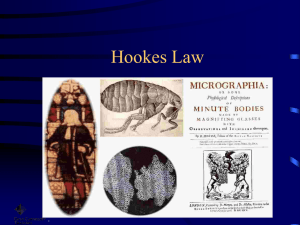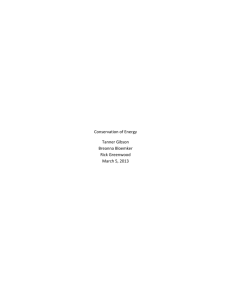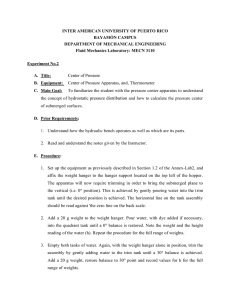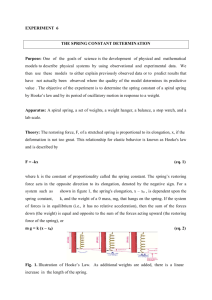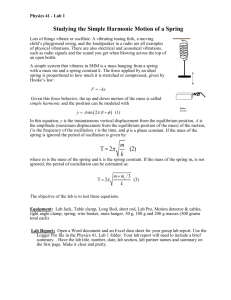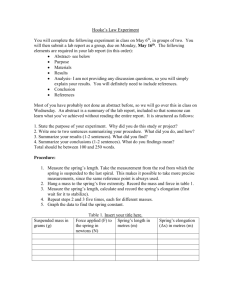Here - Engineering Academic Society
advertisement
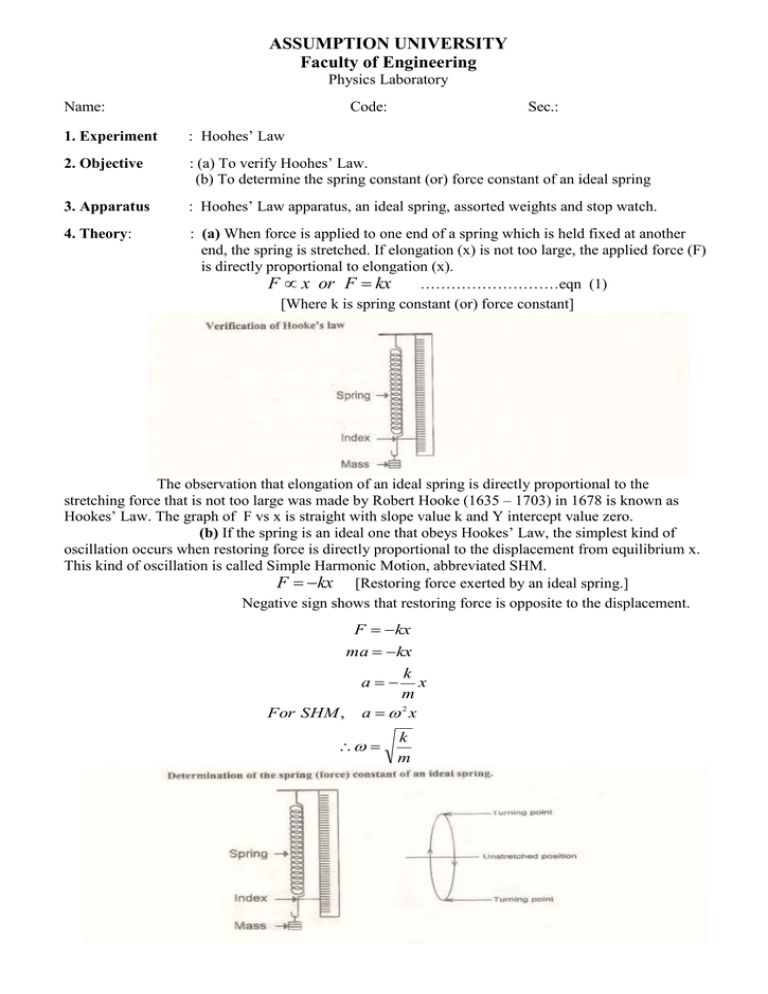
ASSUMPTION UNIVERSITY Faculty of Engineering Physics Laboratory Name: Code: Sec.: 1. Experiment : Hoohes’ Law 2. Objective : (a) To verify Hoohes’ Law. (b) To determine the spring constant (or) force constant of an ideal spring 3. Apparatus : Hoohes’ Law apparatus, an ideal spring, assorted weights and stop watch. 4. Theory: : (a) When force is applied to one end of a spring which is held fixed at another end, the spring is stretched. If elongation (x) is not too large, the applied force (F) is directly proportional to elongation (x). ………………………eqn (1) F x or F kx [Where k is spring constant (or) force constant] The observation that elongation of an ideal spring is directly proportional to the stretching force that is not too large was made by Robert Hooke (1635 – 1703) in 1678 is known as Hookes’ Law. The graph of F vs x is straight with slope value k and Y intercept value zero. (b) If the spring is an ideal one that obeys Hookes’ Law, the simplest kind of oscillation occurs when restoring force is directly proportional to the displacement from equilibrium x. This kind of oscillation is called Simple Harmonic Motion, abbreviated SHM. F kx [Restoring force exerted by an ideal spring.] Negative sign shows that restoring force is opposite to the displacement. F kx ma kx k a x m For SHM , a 2 x k m The period, T is time for one cycle or one complete oscillation. The frequency, f is the number of cycles in a unit time. [ SI unit of frequency is Hertz, 1HZ = 1 cycle / second = 1s-1] The angular frequency, ω is 2πf or 2π times frequency. 2 f 2 T T 2 T2 k m m k 4 2 m k .............................eqn ( 2) 4 2 The graph of T vs m is straight with slope value and Y intercept value zero. k 2 5. (a). INSTRUCTIONS (1) Verification of Hookes’ Law 1. Set up the Hookes’ law apparatus. 2. Take the reading of index when no weight is placed on the hanger for primary reading. 3. Add the weight of about 0.1N [10gmmass] on to the hanger at a time for five consecutive weights and read the corresponding index reading on the vertical scale. 4. Repeat the readings while the weights are gradually decreased one by one. 5. Record the data in the table properly along with each unit. 6. Draw the graph of force (N) versus elongation (m) [F vs x]. 7. Find the slope value of the graph of force versus elongation and determine the spring constant (or ) force constant. 8. Verify Hookes’ Law by using the graph of force (load) versus elongation [F vs x]. 5. (b). INSTRUCTIONS (2) Determination of the spring constant (or ) force constant of an ideal spring. 1. The mass (m) of 20g is suspended on the Hanger of Hookes’ law apparatus. 2. Let the mass and hanger oscillate up and down without swinging. 3. When the hanger with mass is oscillating, the time for 20 oscillation is taken. 4. The period (T) is calculated. 5. The mass is increased 10g at a time and the corresponding period is determined. 6. Repeat for another four different trials for step 2 to 4. 7. Find the effective mass for each trial. 8. Draw the graph of period squared versus effective mass (T2 vs m). [Where m is the effective mass for the oscillation.] 9. Find the slope value of the graph of period squared versus effective mass (T2 vs m). 10. Deter mine the spring constant (or ) force constant of an ideal spring. 6. ASSIGNMENT QUESTIONS 1. Verify Hookes’ Law by using the graph of force (load) versus elongation [F vs x]. 2. What is the effective mass for Hookes’ Law experiment? 3. Explain whether or not the spring constant in the Hookes’ law apparatus remain constant if the increment steps are not regular and the elastic limit of the spring is not exceeded. ***************************************************************************** SOME CONCEPTS, IMPORTANT POINTS AND EXAMPLES Hookes’ Law apparatus is essentially a spring suspended vertically and supported from one of its end on a stand. The lower end of the spring is attached to a pointer or index and from this end of the spring is suspended to hanger or a scale pan. Behind the index it is fixed vertical linear scale on which the position of index is read. Hookes’ Law is not really a general law but an experimental finding that is valid only over a limited range. Beyond the elastic limit, Hookes’ Law is valid. If you stretch the spring beyond its elastic limit, the spring will be permanently deformed. Primary index reading is the reading of index when there is no weight is placed on the hanger. If primary index reading is zero, the elongation can be obtained easily. F kx , is a linear equation. The graph of F versus x is a straight line that has Y intercept value zero and slope value is k. When you perform the instruction’2’ , to get the hanger with mass oscillate up and down without swinging, lift up straight the hanger with mass for small movement. 4 2 T m k 2 ‘T’ is the period of oscillating spring, ‘m’ is effective mass of that oscillation. Effective mass = mass of spring 3 + mass of hanger + mass on the hanger You need to count the number of oscillations for ‘20’ times when you measure the time for ‘20’ oscillations. When you switch on the stopwatch, at that moment you need to count the oscillation as zero and when oscillation is completed one you need to count one, when oscillation is completed two you need to count two and so on up to ‘20’ oscillations. At the moment when you switch on the stopwatch, if you count as one the number of oscillations will be less one what ever you need. This is very important point to get exact number of oscillations. Name: Code: Sec.: Recording data Data taking for verification of Hookes’ Law Primary index reading………………………………………m Suspended weight (Force in N) No Index Reading Weight Weight increasing decreasing (m) (m) Average index reading (m) Elongation (x) (m) Force elongation (N / m) 1 2 3 4 5 Average value of Force elongation = Data taking for determination of the spring constant (or ) force constant of an ideal spring Effective mass = 1. mass of spring 3 + mass of hanger + mass on the hanger Effective mass = ………………………………………..………………………….kg 2. Effective mass = ……………………………………………….…………………….kg 3. Effective mass = …………………………………………………….……………….kg 4. Effective mass = …………………………………………………………………/….kg No 1 2 3 4 Mass on the hanger (g) Effective mass (kg) Taken time for 20 oscillation (s) Period (T) T2 (s) (s2)
